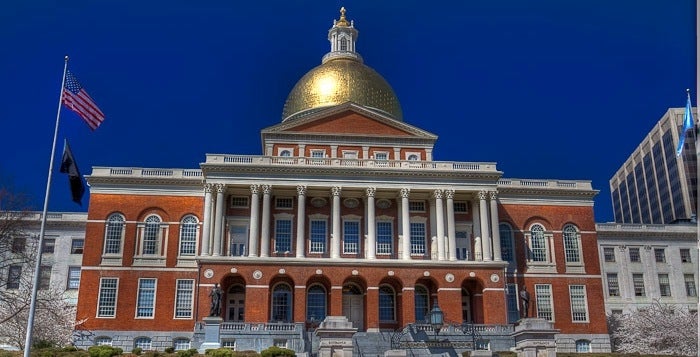Mass. finalizes rules to net additional emissions reductions
 The Baker administration is releasing regulations aimed at reducing greenhouse gases.
The Baker administration is releasing regulations aimed at reducing greenhouse gases.
Declaring combating climate change and preparing for its impacts as a "top priority," the Baker administration on Friday will release its final regulations specifically aimed at reducing greenhouse gas emissions from the natural gas, transportation and electricity generation industries.
The regulations, which will be officially published Friday by the secretary of state's office, were assembled by the executive branch after the Supreme Judicial Court ruled in May 2016 that Massachusetts must seek emissions reductions across an array of economic sectors to meet the legal requirements of the state's Global Warming Solutions Act (GWSA).
That 2008 law requires the state to achieve greenhouse gas emissions reductions of 25 percent below 1990 emissions levels by 2020 and a reduction of at least 80 percent by 2050. As of 2014, the state had reduced emissions by 21.3 percent from 1990s levels, according to the most recent data available from the Department of Environmental Protection (DEP). The regulations to be released Friday -- two new regulations and four amendments to existing regulations -- are expected to result in an additional 6.2 percent reduction by 2020, DEP Commissioner Martin Suuberg said, surpassing the GWSA requirement.
"What we were trying to accomplish with the court order was to come up with a set of regulations that made us in compliance with the Global Warming Solutions Act, that put into regulations the reductions that will see us to that last 3.7 percent that we have to go to meet that 2020 goal of a 25 percent reduction," Energy and Environmental Affairs Secretary Matthew Beaton said. "We are trending in a very good direction and we are very confident that we are going to hit those goals."
Asked how the administration can be certain the state's emissions are in fact 21.3 percent below 1990 levels given the changes in the energy landscape since that data was gathered in 2014, Suuberg said his team used a variety of data sources to get the most complete picture of emissions and tried to address the changes in the market.
"I think we have a fair amount of confidence in the projections we have and I think we are trying to make sure we are taking into account the changing energy market -- the facilities that are coming offline and the facilities we're likely to see come online," he said.
The regulations, which will take effect immediately, also stem from an "integrated climate change strategy" executive order Gov. Charlie Baker issued last September.
The regulatory package seeks to extract emissions reductions from the natural gas distribution network, the transportation sector, gas-insulated switchgear, electricity generation and consumption. The regulations also feature declining carbon dioxide emission limits for state government's fleet of passenger vehicles and call for methane emission reductions from natural gas mains and services, and a clean energy standard for retail electricity sellers.
"These regulations will help ensure the commonwealth meets the rigorous emission reduction limits established in the Global Warming Solutions Act in order to protect our residents, communities and natural resources from the effects of climate change," Baker said in a statement.
The transportation sector is the single largest sector of greenhouse gas emissions in Massachusetts, according to DEP, accounting for 40.8 percent of such emissions in 2013. The electric sector is the second largest in Massachusetts, with emissions from homes and businesses accounting for about 21.5 percent of all emissions, according to the DEP.
Administration officials said they project that the regulations will result in 1 to 2 percent higher costs to electric ratepayers each year until 2020 when additional forms of clean energy, like offshore wind and hydro power, are expected to be available to Massachusetts.
The Conservation Law Foundation, which was a plaintiff in the Kain vs. Massachusetts Department of Environmental Protection case that led to the regulations, worked closely with EEA as the administration developed the regulations and was pleased with the final result.
"These rules re-establish the Commonwealth as a national leader in developing sensible, enforceable standards to transition our economy to a low-carbon future," CLF President Bradley Campbell said in a statement. "Much more needs to be done, and Governor Baker's leadership will be essential to getting neighboring states to take meaningful action to prepare New England for the energy future being shaped by the Paris Climate Agreement."
Suuberg thanked CLF, which is often at odds with state government, for working with the administration as they developed the final regulations.
"The CLF was the successful plaintiff in the Kain decision and even though this began in an adversarial, judicial process, they have been thoughtful in their participation and, I believe, thoughtful in their comments," he said, noting that EEA received about 300 written comments after draft regulations were released in December.
But 350 Mass, an environmental advocacy organization, said the regulations will not do enough to uphold the governor's commitments when he joined the multi-state U.S. Climate Alliance.
"The regulations do not touch over 85% of Massachusetts' climate pollution, leaving out entire sectors such as non-governmental transportation and heating. To meet our climate action mandates, these regulations should have included all of our major sources of pollution. In 2017, small, incremental steps like this are no longer adequate," Craig Altemose, executive director of 350 Mass, said in a statement. "Governor Baker talks a good game on climate action, but issuing weak regulations and supporting pipeline construction are policy moves that have more in common with the Trump administration than Governor Baker would like to admit.
Beaton acknowledged that Massachusetts will not meet the 2050 requirements of the GWSA unless the state does more to address emissions from the transportation sector. The regulations published Friday will hold state executive offices that have at least 30 vehicles to an annually declining cap on emissions and set annual limits on carbon dioxide emissions the Department of Transportation is required to meet.
"The whole world right now is wrestling with the transportation sector and the challenges around dealing with it relative to climate mitigation. We've been in a number of conversations about identifying solutions for transportation, whether it's done on a regional basis," Beaton said. "It is a big challenge. We recognize that challenge, we see it as a challenge as well. But we are confident that in the very near future some of the efforts and the conversations we are having with our colleagues in other states and other provinces in Canada that there will be great strides to better understand what our options are for transportation solutions."
Beaton also suggested that the Baker administration is working to establish its own emission reduction targets for 2030 and 2040 to make sure Massachusetts stays on track to meeting the 2050 requirements, something Sen. Marc Pacheco has filed bills to do.
In June, the Committee on the Environment, Natural Resources and Agriculture endorsed a Pacheco bill (S 479) setting a requirement of reducing emissions between 35 and 45 percent below 1990 levels by 2030 and a requirement of 55 percent to 65 percent below 1990 levels by 2040. Baker, in conjunction with New England governors and Eastern Canadian premiers, has agreed to a goal of a 35-45 percent emissions reduction for the region by 2030.
"We are working towards doing that ourselves," Beaton said. "We view that as being an important part of it, the long-term vision."









0 Comments